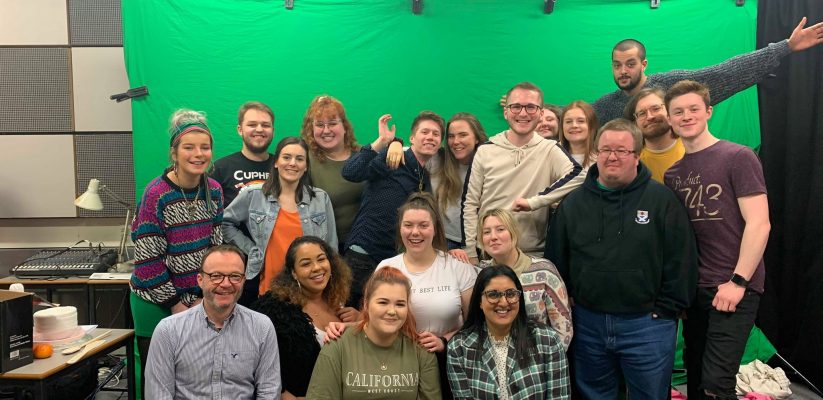Production Week 1
During our pre-production weeks, it was decided that our pop-up radio station would be a London-based station about food aimed at a 22-33 age group. The name ‘Bite’ was chosen, and I put myself forward to manage the station’s audio and visual branding, with Josie assisting me. I also put myself forward to work with Pulama on the social media/web team. I started work on an early concept version of the visual branding, which went through a number of alterations during the first production week.
The early version of the logo was a leaf-type shape which included a bite mark. The colour scheme was chosen because it was bright and punchy, which felt right for the largely Millennial audience. The font is bold and rounded, designed to be friendly and clear.
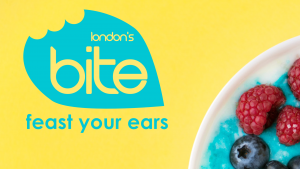
During the first production week, I modified the concept version of the logo. It was noted that the initial choice of colours did not communicate food. Some research was carried out which indicated that the colour orange has a psychological association to food. The first alteration therefore featured an orange and yellow colour scheme, and the shape of the logo was changed to represent an orange fruit, and to generally simplify the design. The bite mark which featured in the first version of the design was still included in the second draft, as well as the typeface.
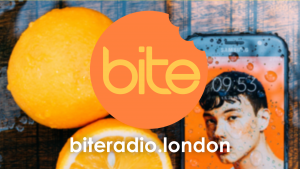
This simple round shape was much closer to the final design, but it was eventually decided that although the orange colour scheme was good conceptually in that the colour has a psychological association with food, the colour combination was unfortunately not strong enough to be read from a distance or when displayed very small such as on social media icons.
I then had the idea to create four versions of the logo, each with a different colour scheme relating to the theme of the week. This concept was inspired by the colour-changing ITV logo of 2013, which adapts to its surroundings depending on its context.
As shown below, Vegan Week will sport a green version of the logo, World Food Week will be red, Seafood Week will be blue-green, and Dessert Week will showcase a pink version. I think this dynamic logo will help emphasise the broad range of cuisines that Bite will cover over the four weeks.
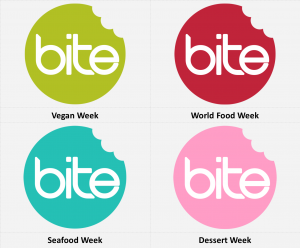
In addition to the visual branding, I worked on producing the audio imaging of the station. I carried out some research into the sound of cookery television programmes such as Nadiya’s British Food Adventure. My research indicated that cooking shows, regardless of target audience, primarily have an orchestral sound. This was useful in building the sound of the station. I chose to use orchestral beds, which also had a simple, relaxed sound. I also decided to include a crunch sound effect as the station’s signature sting. I also included many cookery sounds within the imaging, which Josie assisted me in sourcing. These included the sound of a hob being turned on, boiling water and popcorn popping in a microwave. I later realised that I should make these sounds relevant to each week’s theme, and I will work on planning and producing this themed imaging during Production Week 2. Currently my voice is being used on the imaging for the pilots, but I have sourced a female voiceover artist with a neutral British accent, and a script will be sent to her after our first pilot, to ensure we have everything scripted that we need. Josie has assisted me in the writing of the voiceover script. The voiceover artist was chosen because her voice is calm and fits with the sound of the station.
This week I have also assisted Pulama with the technical aspect of setting up the website. We decided to use WordPress due to its versatility and we are both familiar with the CMS.
Production Week 2
During production week 2, I produced a Media Pack for potential advertisers and clients which outlines what Bite is about as a brand and what we plan to do over the four weeks we are on air. I took inspiration from other radio station Media Packs such as Magic and Eagle Radio. This document is a professional way to sell the concept of the station and I believe will help us secure stronger advertisers and interview opportunities. Click here to download the Media Pack.
I also assisted Pulama with the presenter photoshoot, and edited the photographs using Adobe Photoshop to remove the background of the images. I then uploaded the images to the website and improved the layout of the Programme Schedule page on the website, as well as creating a show page for Lunch with Kaylee & Joe. My versions of the pages are early mock-ups for Pulama to change however she sees fit.
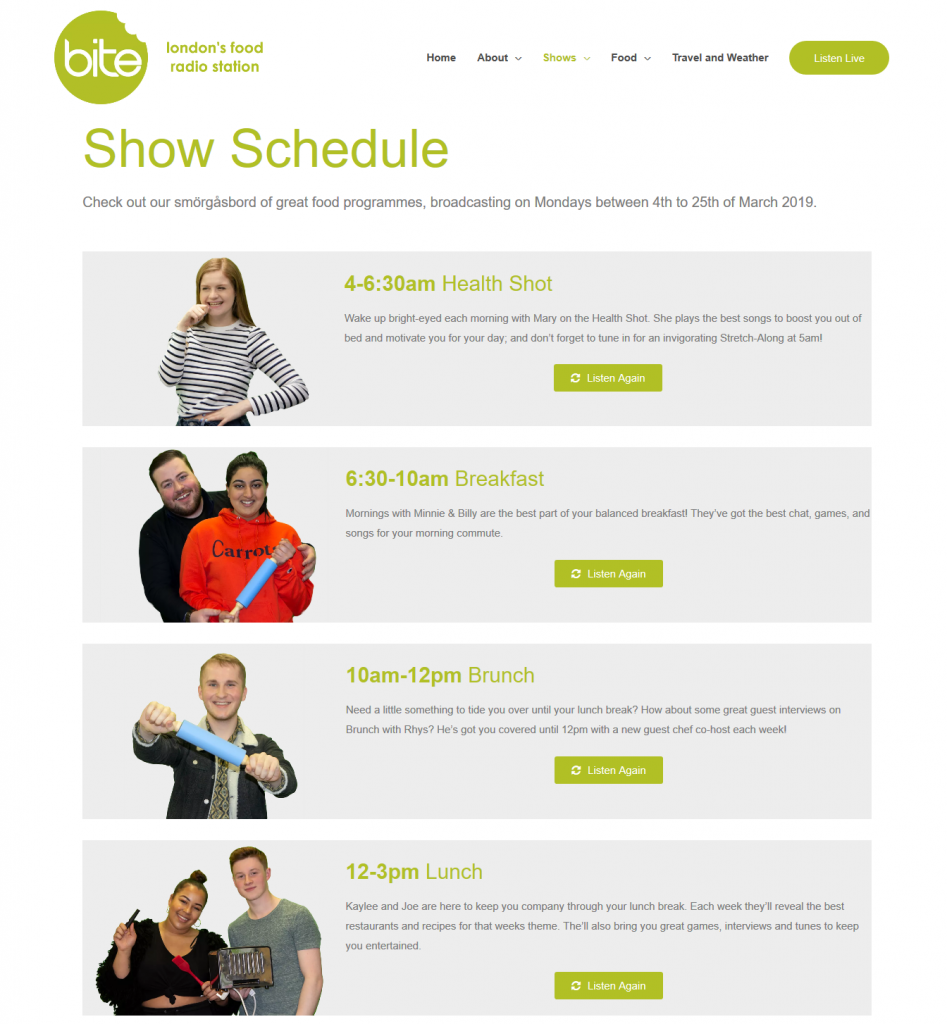
On the Sunday, I recorded the voice session with our voiceover artist, a friend of Mary who has a soft and neutral British accent which sounds perfect for the tone of the station. This involved refining Josie’s draft version of the script. My version of the script included lines for on-air content as well as social media content. As our voiceover artist was only available on Sunday evening, the turnaround time to get the imaging produced for the final pilot show the following day was too short notice, so we used the mockup versions for Monday’s broadcast.
Pilot Week
This week I worked on producing the final imaging for Vegan Week. I made the jingles more themed towards the week using more natural cookery sound effects. I also altered the newsramp and created a weather jingle. I loaded this imaging onto Myriad and set all the cue points. I also produced a Breakfast Show trail which was played out during the programme. Rhys voiced 4 versions of this trail for each of the weeks.
I also worked with Pulama to plan and produce a four-part cookery video series for our social media channels which features Sitara Juhi, a food blogger. In each video, Sitara cooks a different recipe which will be related to the theme of the week. This video series was my concept and will be one of our flagship video pieces. We recorded all four videos with Sitara in her kitchen in Slough on Saturday 2nd March. I liaised with Sitara to make this project happen and have organised a budget with Mary for the ingredients required for the recipes. We used multiple cameras to make the piece high quality. Pulama and I directed Sitara collaboratively. We initially decided that I would edit Vegan and Dessert Week and Pulama would edit Seafood and World Food Week, but we later changed this plan as we realised it was easier for me to edit all four videos for consistency. During filming, we had issues with the boom mic which we brought, so I decided to use the audio of the camera’s microphone as it sounded better quality than the boom’s audio.
I scheduled the video to go out on Facebook and YouTube like a live video, so users can comment on the video as it is playing, making it more interactive.
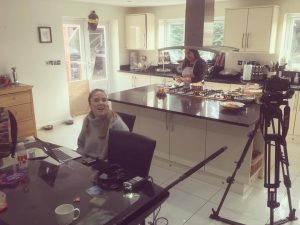
Additionally, I created the pop-up radio player on the Bite website, allowing people to listen to the stream in a separate window. This was quite a technical and time consuming project as involved creating a mini version of the website using code outside of WordPress, uploading this to the server via FTP, and also installing a plugin which enables the “Listen Live” button to open as a pop-up window.
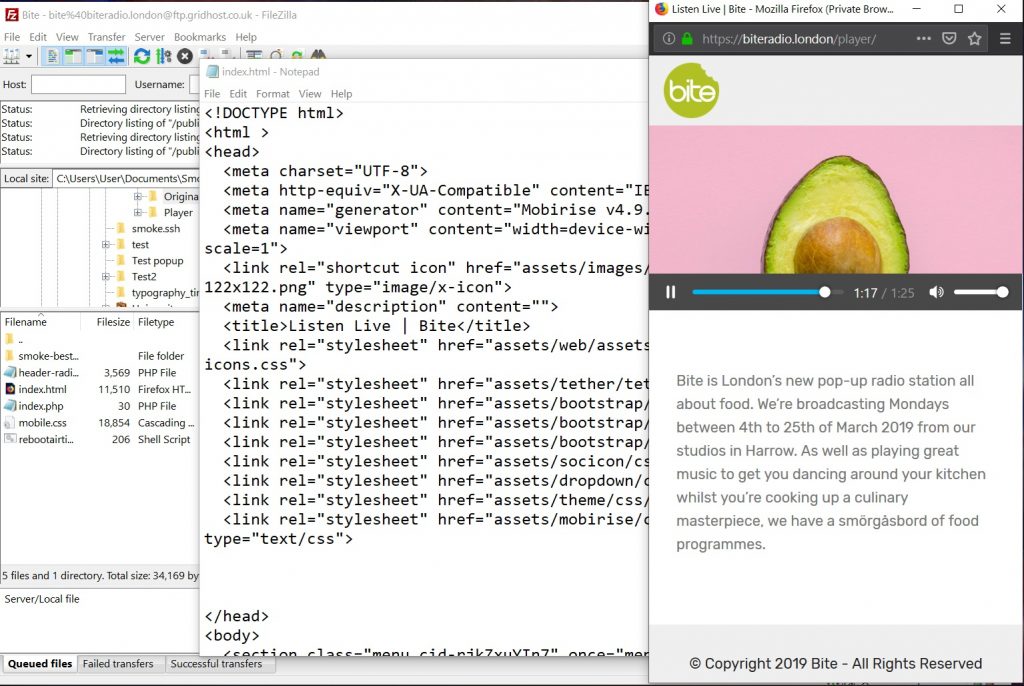
On Air Week 1
I was asked to produce a drone for the competition reveal and also a zing to separate songs during the music hour. I made these fit the brand by ensuring they contained food-related sounds.
Before our first live show, Pulama and I filmed a video version of the show menu with Kaylee and Joe in front of the green screen, and I edited this and posted it to the social networks. During the show, I was based in the studio, relaying information from the broadcast team to the social team. I made sure content directly related to the show went out at the right time, including polls and competition tweets.
Feedback after the show suggested we needed to post more content during the show, so I suggested to Pulama that we post some key show images on the Facebook and Instagram Stories, which Pulama agreed with. We had previously decided against doing this as we felt we had a clear aesthetic for all our posts which did not match up with “spur of the moment” snaps. To combat this, I produced a template graphic to put over any photographs to make them more branded and match our overall aesthetic.
During the week, I edited the “What The Food” video which went out on Wednesday and uploaded the first Podcast which Pulama edited. I set up an account on Anchor.fm so that our podcast can be distributed on all platforms including iTunes, Spotify and Google Play.
As well as this, I edited the second version of “Snacks with Sitara” and scheduled it to be posted on Monday. I also produced the imaging for World Food Week. The initial concept for the sound of the station this week was to include segments of world music, but I found this made our main imagine deviate too far from our brand style. Instead, I have sourced world music as beds for different segments of the show, but the main imaging (IDs and ramps) use the Bite music but have been adapted to fit the theme of the week, but include voiceovers which say “London’s Food Radio Station” in various languages. I was happy with how the final imaging sounded for World Food Week.
Mary and Rhys requested I source the sound of an aeroplane to be used to signify the programme is focussing on a different country. I also produced the World Food breakfast promo.
On Air Week 2
I arrived at 8:30am and loaded all the imaging onto the system, and set the cue points, I also helped Pulama set up the green screen. I asked Josie to transcribe “Snacks with Sitara” into a recipe format to go onto the website alongside the video. Before the show, me and Pulama filmed the show menu with Kaylee and Joe, and I edited it and posted this to the social networks. During the show, I took a photograph of a live interview which was posted to Facebook, and ensured all show-specific content was posted at the right time. I created polls on Instagram Stories and composed the competition tweets.
After the show, the written feedback mentioned that the ads were quieter than the imaging, so I told the ad team to make sure everything they produce goes through the Hard Limiter process on Adobe Audition so that it is the same volume as the imaging. I also informed Phoebe who also needs to do this for a package she is creating.
During the week, I worked on producing the imaging for Seafood Week. I sourced various nautical sounds such as waves crashing, seagulls and a ship’s horn. These sounds were woven into the imaging to give it a nautical sound. Additionally, I edited the third instalment of “Snacks with Sitara”, and the second “What The Food?” I also produced a graphic in the seafood colour to be placed on photographs so that they are branded, and uploaded the World Food podcast which Pulama edited.
On Air Week 3
I arrived early Monday morning to load the imaging onto the system and set cue points. Pulama was busy so asked me to set up the green screen for her. There was a pre-recorded interview in the morning so I took a photograph of the guest in the studio and edited the branding template I had made previously onto the photo using Adobe Photoshop.
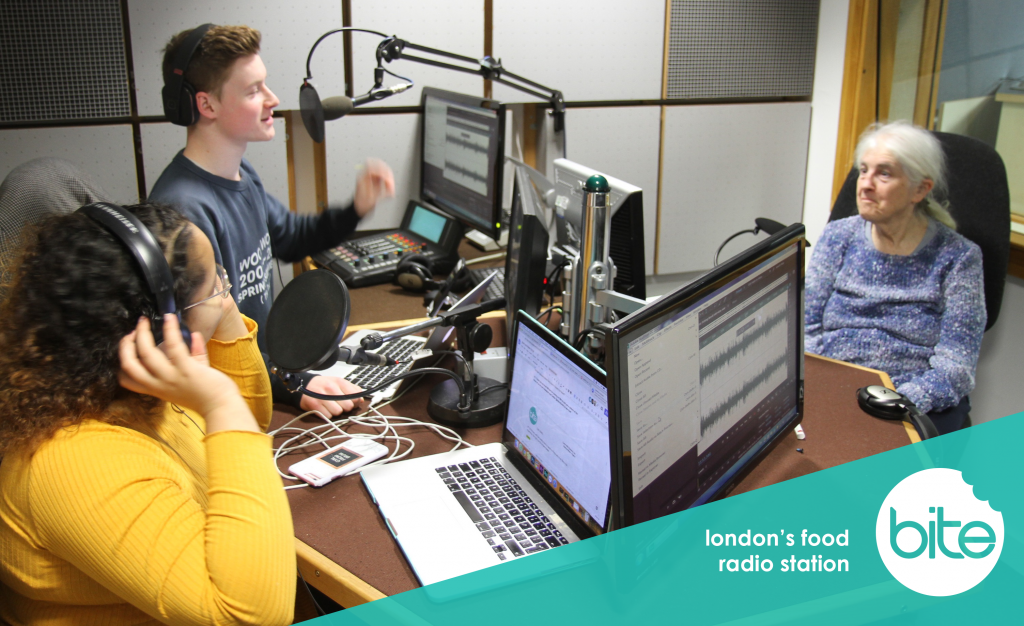
I asked Josie to once again transcribe “Snacks with Sitara” into a recipe format. Pulama and I filmed this week’s show menu which I edited and published online. I was once again situated in the studio during the programme, and ensured all show-specific content was posted at the right time. I created Instagram Stories and composed the competition tweets.
After the show, we had a meeting about the plans for our final week. We decided to visualise the show in RP2, and I took on the responsibility of visualisation as it is something I am interested in but have never had the chance to do myself. This meant I would have to take a backseat from producing social media content this week. This will be a multi-camera project, broadcast to Facebook, Twitter and YouTube simultaneously. We borrowed a large green screen to green screen Kaylee and Joe and any guests onto a branded background live.
During the week I organised the technicalities of the visualisation with Tim and the Students’ Union, and learnt about Wirecast, the vision mixing software, as well as the various livestreaming platforms. I decided to additionally broadcast to Twitch as it has the least issues with copyright infringement of songs, so I embedded the Twitch player onto the pop-out player on website. I also created a number of motion graphics to be used between songs (pictured below). Once I had a copy of the running order, I sourced permission to use images of guests as graphics during phone interviews.
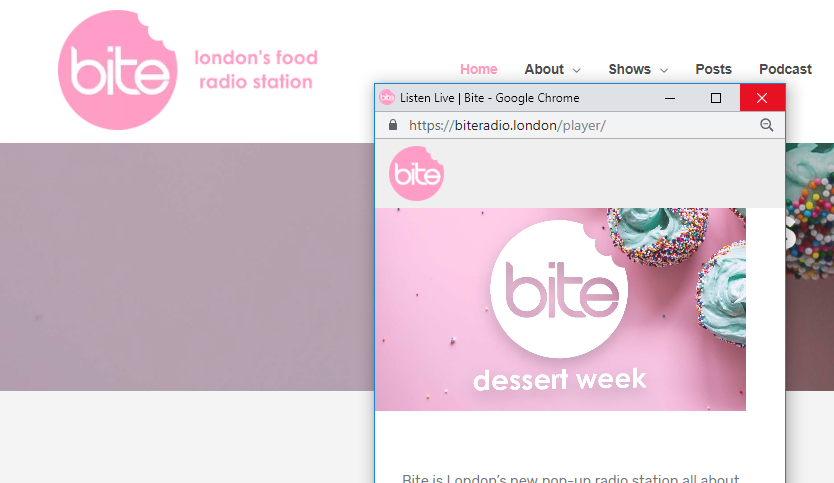
On Friday I set up and tested all of the equipment and ironed out any technical issues, with the assistance of Matthew Sanders and Tim Carter. Jason and Joe were also a great help, as they assisted with setting up the studio and sourcing a high table from the SU bar.
It became apparent that it was technically simplest to broadcast the show from RP2 and visualise every link, rather than only some links. I was very happy with how the green screen background looked, which was a royalty free image of a designer kitchen from multiple angles, which matched the angles of the cameras. I familiarised myself with Wirecast, the vision mixing software, which I had never used before. One major technical issue which took me and Matthew a long time to overcome was that the sound from the studio was only coming into the vision mixing computer as the left channel, and very distorted. Matthew eventually solved this issue for me by setting the audio up differently in the software, and by lowering the volume of the input considerably. The final sound quality of the visualised stream was good. A second technical challenge to overcome, was that I realised broadcasting to multiple sources (Facebook, Twitch, YouTube and Twitter) was too intensive for the Wirecast machine. After some research, I discovered a free service called Castr.io which allowed me to stream to one location, and for that to then be re-broadcast via the cloud, bypassing the CPU-intensive process for the Wirecast computer. I am very proud that we conquered all the technical and logistical challenges thrown at us.
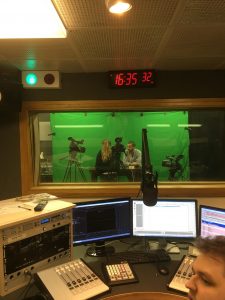
I created some Dessert Week-specific Bite jingles which included the sound of an egg timer – I thought this was appropriate for baking and desserts. This is more of a subtle theme-sound than previous weeks because I found it harder to think of theme-specific sounds this week. I also didn’t want the brand to deviate too much from the already clearly established station sound. I also created an amended version of “Food News” which included the words “…on Bite” and a jingle for the “Cook-Along”. The Cook-Along imaging was inspired by the Great British Bake-Off theme tune because I wanted the imaging to sound familiar. I also produced a Dessert Week version of the breakfast trail. Finally, I edited and scheduled the final “Snacks with Sitara” which I decided to also play on the stream directly after the show finishes at 3pm.
On Air Week 4
I wanted to arrive as early as possible on Monday morning as I knew I had far more to do during the show than on previous weeks. I arrived at 8am, and imported all the new imaging onto Myriad. I then imported some of the graphics I had made during the week onto the vision mixing computer, and set up the streams ready to go live. We did some tests in the morning and unfortunately I was unable to stream to Twitter, but this was the only service which was unable to be streamed to, so although this was a bit of a shame it wasn’t the end of the world as it was still available to be watched on Facebook, YouTube and Twitch through the pop-up player on the Bite website.

During the show, I was situated in RP2 operating the vision mixing software. I was proud I managed to do this despite it being my first time operating a live vision mixing program. The full show can be watched here. After the show, I also uploaded the audio version onto the Bite website.
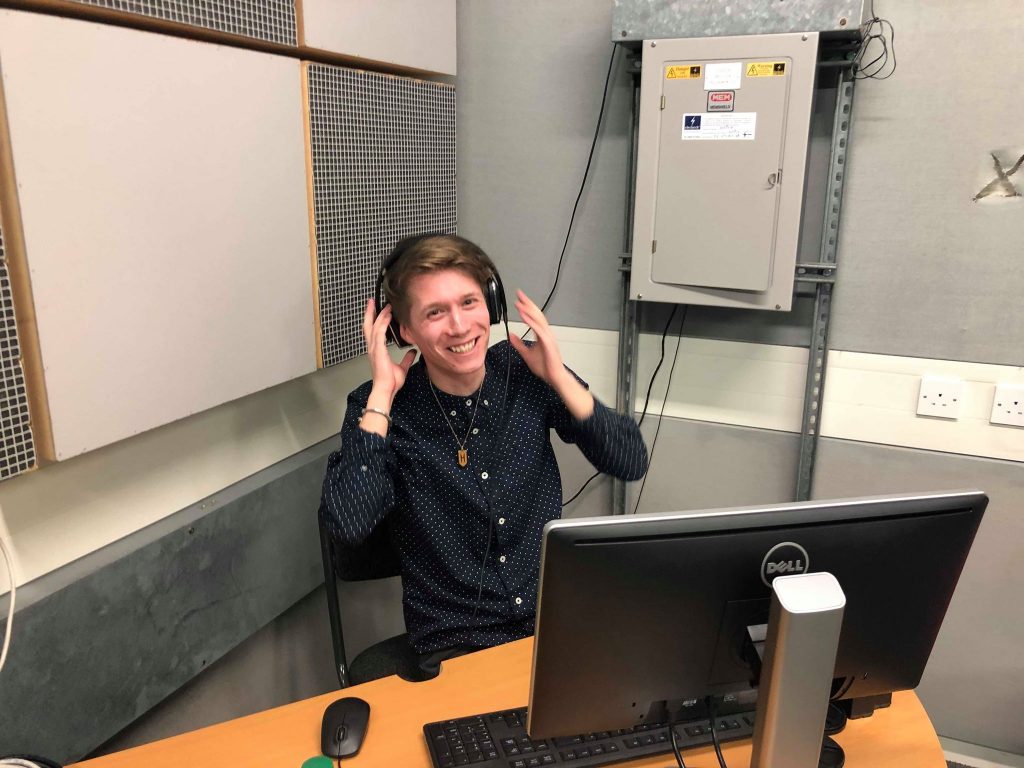
Altogether I have found this the most demanding but also most enjoyable module of my three years at university. It has been a pleasure to work with the group and I have genuinely enjoyed it immensely. I’ve been challenged to produce my best work, and feel proud of what I’ve created both by myself and with other members of the team. I am particularly happy with the visualisation of the final week as I think it looked really good and was a big technical challenge to overcome. I am also happy with the amount of views and interaction the video series “Snacks With Sitara” gained. At the time of writing, the series received 1,831 views in total, with many positive comments on each video.
